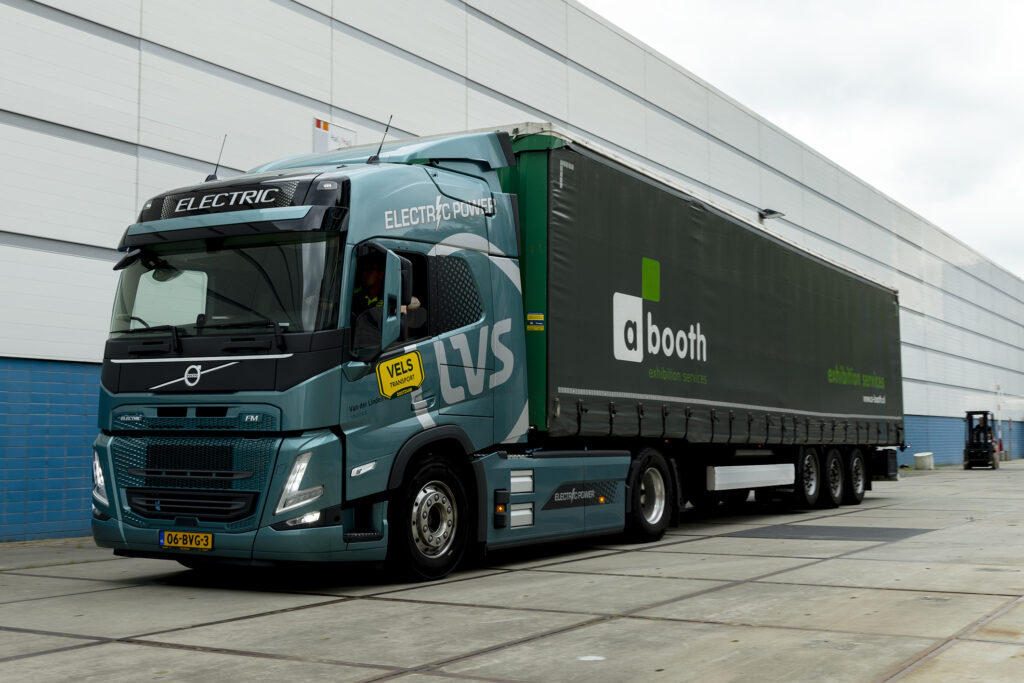SIGNIFICANT STEP TOWARDS SUSTAINABLE OPERATIONS
‘Charging stress’ is a common phenomenon for drivers of passenger cars who have switched to fully electric driving. For stand builder A-Booth and transport partner Vels Transport, there was no stress involved. Last Wednesday’s test transport from Oostzaan to the Jaarbeurs and RAI went smoothly. The range of the Volvo truck was more than sufficient to cover the distance to Utrecht and back via Amsterdam. Fully electric driving results in a 100% reduction in CO2 emissions, aligning with A-Booth’s goal of achieving climate-neutral operations by 2030.
Vels Transport is one of A-Booth’s regular transport partners. Within the Netherlands, the stand-building company, specializing in modular systems, extensively utilizes Vels’ services. ‘We have set the goal of reducing our CO2 emissions by 50% by 2026 and bringing it down to zero by 2030. This heavily depends on the possibilities in freight transport since it is the primary source of emissions within our company. In recent months, we have been in regular discussions with Vels about what needs to be done to reduce these emissions,’ says Chris van Dam, a director at A-Booth. ‘Furthermore, inner-city locations will no longer be accessible with diesel transport in a few years. So, we are looking for more sustainable alternatives.’
The expectation was not that the transport would be unsuccessful, but it was essential to understand the aspects involved in deploying an electric-powered truck. ‘We had to deliver materials to the Jaarbeurs for the Public Space Trade Fair. Then, the truck drove to Amsterdam with an empty trailer to pick up materials at RAI after the IBC dismantling. And from there, back to Oostzaan,’ explains Van Dam. Raymond Faydherbe, operations manager at Vels Transport, adds, ‘It’s perfect driving for the driver. The truck is super quiet and meets all the requirements of modern transport. We already have an electric vehicle with a crane on it, so we have some experience with intermediate charging. To optimize the use of the vehicle, it would be enormously helpful to have fast-charging capabilities on-site. Until that’s available, you’ll need to consider your range and charging points. Charging at our location overnight takes 8 hours to reach a full charge. With a fast charger, we can reach 80% charge in an hour.’
The truck used for the pilot has a range of between 300 and 400 kilometers. Soon, new models will be available on the market that can go an additional 150 kilometers. ‘For us, these are excellent performances,’ believes Van Dam. ‘We are located only 20 kilometers from RAI Amsterdam and less than 50 from Jaarbeurs. In the future, we can execute all these trips electrically. Furthermore, when we commute, we can charge in between while the truck is loaded, as we are quite self-sufficient with a charging point and 500 solar panels at our location in Oostzaan,’ he continues.
The downside for both companies is the purchase price of the truck, which is twice as expensive as the diesel engine alternative. Although there is a subsidy fund, Vels was unsuccessful in the last application. ‘We hope to be eligible for subsidies in the next application,’ says Faydherbe. ‘But no matter how you look at it, this is a development that has been set in motion and is irreversible. As a company, you have to participate; there is no alternative.’


